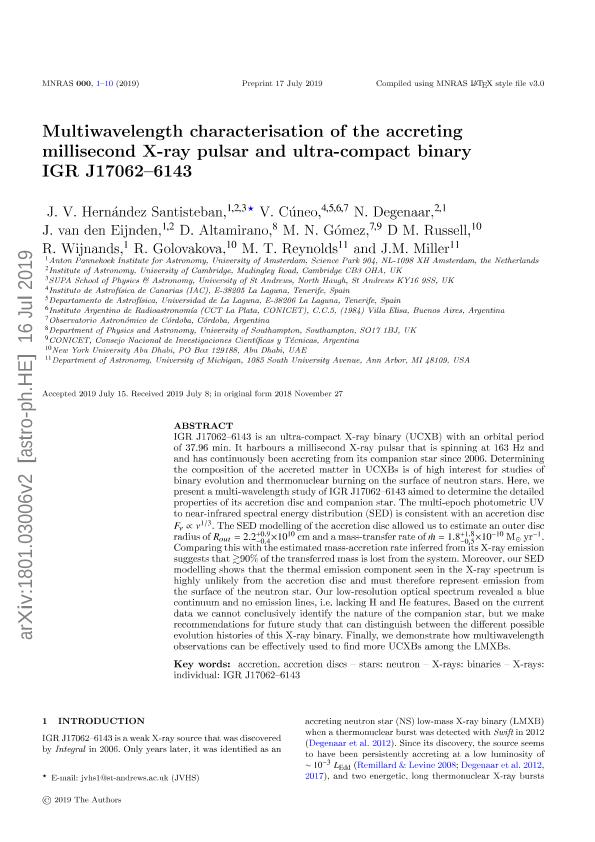Mostrar el registro sencillo del ítem
dc.contributor.author
Hernández Santisteban, Juan V.

dc.contributor.author
Cuneo, Virginia

dc.contributor.author
Degenaar, N.
dc.contributor.author
van den Eijnden, Jakob

dc.contributor.author
Altamirano, D.
dc.contributor.author
Gómez, Matías Nicolás

dc.contributor.author
Russell, David M.

dc.contributor.author
Wijnands, R.
dc.contributor.author
Golovakova, R.
dc.contributor.author
Reynolds, M. T.
dc.contributor.author
Miller, J. M.
dc.date.available
2021-04-15T14:35:32Z
dc.date.issued
2019-10
dc.identifier.citation
Hernández Santisteban, Juan V.; Cuneo, Virginia; Degenaar, N.; van den Eijnden, Jakob; Altamirano, D.; et al.; Multiwavelength characterization of the accreting millisecond X-ray pulsar and ultracompact binary IGR J17062-6143; Wiley Blackwell Publishing, Inc; Monthly Notices of the Royal Astronomical Society; 488; 4; 10-2019; 4596-4606
dc.identifier.issn
0035-8711
dc.identifier.uri
http://hdl.handle.net/11336/130104
dc.description.abstract
IGR J17062-6143 is an ultracompact X-ray binary (UCXB) with an orbital period of 37.96 min. It harbours a millisecond X-ray pulsar that is spinning at 163 Hz and and has continuously been accreting from its companion star since 2006. Determining the composition of the accreted matter in UCXBs is of high interest for studies of binary evolution and thermonuclear burning on the surface of neutron stars. Here, we present a multiwavelength study of IGR J17062-6143 aimed to determine the detailed properties of its accretion disc and companion star. The multi-epoch photometric UV to near-infrared spectral energy distribution (SED) is consistent with an accretion disc Fν ∝ ν1/3. The SED modelling of the accretion disc allowed us to estimate an outer disc radius of Rout = 2.2+0.9−0.4 × 1010 cm and a mass-transfer rate of m = 1.8+1.8−0.5 × 10−10 M☉ yr−1. Comparing this with the estimated mass-accretion rate inferred from its X-ray emission suggests that ≿90 per cent of the transferred mass is lost from the system. Moreover, our SED modelling shows that the thermal emission component seen in the X-ray spectrum is highly unlikely from the accretion disc and must therefore represent emission from the surface of the neutron star. Our low-resolution optical spectrum revealed a blue continuum and no emission lines, i.e. lacking H and He features. Based on the current data we cannot conclusively identify the nature of the companion star, but we make recommendations for future study that can distinguish between the different possible evolution histories of this X-ray binary. Finally, we demonstrate how multiwavelength observations can be effectively used to find more UCXBs among the LMXBs.
dc.format
application/pdf
dc.language.iso
eng
dc.publisher
Wiley Blackwell Publishing, Inc

dc.rights
info:eu-repo/semantics/openAccess
dc.rights.uri
https://creativecommons.org/licenses/by-nc-sa/2.5/ar/
dc.subject
ACCRETION
dc.subject
ACCRETION DISCS
dc.subject
STARS: NEUTRON
dc.subject
X-RAYS: BINARIES
dc.subject
X-RAYS: INDIVIDUAL: IGR J17062-6143
dc.subject.classification
Astronomía

dc.subject.classification
Ciencias Físicas

dc.subject.classification
CIENCIAS NATURALES Y EXACTAS

dc.title
Multiwavelength characterization of the accreting millisecond X-ray pulsar and ultracompact binary IGR J17062-6143
dc.type
info:eu-repo/semantics/article
dc.type
info:ar-repo/semantics/artículo
dc.type
info:eu-repo/semantics/publishedVersion
dc.date.updated
2021-03-25T13:54:48Z
dc.journal.volume
488
dc.journal.number
4
dc.journal.pagination
4596-4606
dc.journal.pais
Reino Unido

dc.journal.ciudad
Londres
dc.description.fil
Fil: Hernández Santisteban, Juan V.. University of Amsterdam; Países Bajos. University of Cambridge; Reino Unido. University of St. Andrews; Reino Unido
dc.description.fil
Fil: Cuneo, Virginia. Universidad Nacional de Córdoba. Observatorio Astronómico de Córdoba; Argentina. Instituto de Astrofisica de Canarias; España. Universidad de La Laguna; España. Provincia de Buenos Aires. Gobernación. Comisión de Investigaciones Científicas. Instituto Argentino de Radioastronomía. Consejo Nacional de Investigaciones Científicas y Técnicas. Centro Científico Tecnológico Conicet - La Plata. Instituto Argentino de Radioastronomía; Argentina
dc.description.fil
Fil: Degenaar, N.. University of Amsterdam; Países Bajos. University of Cambridge; Reino Unido
dc.description.fil
Fil: van den Eijnden, Jakob. University of Amsterdam; Países Bajos. University of Cambridge; Reino Unido
dc.description.fil
Fil: Altamirano, D.. University of Southampton; Reino Unido
dc.description.fil
Fil: Gómez, Matías Nicolás. Universidad Nacional de Córdoba. Observatorio Astronómico de Córdoba; Argentina. Consejo Nacional de Investigaciones Científicas y Técnicas. Centro Científico Tecnológico Conicet - Córdoba; Argentina
dc.description.fil
Fil: Russell, David M.. New York University Abu Dhabi; Emiratos Arabes Unidos
dc.description.fil
Fil: Wijnands, R.. University of Amsterdam; Países Bajos
dc.description.fil
Fil: Golovakova, R.. New York University Abu Dhabi; Emiratos Arabes Unidos
dc.description.fil
Fil: Reynolds, M. T.. University of Michigan; Estados Unidos
dc.description.fil
Fil: Miller, J. M.. University of Michigan; Estados Unidos
dc.journal.title
Monthly Notices of the Royal Astronomical Society

dc.relation.alternativeid
info:eu-repo/semantics/altIdentifier/url/https://ui.adsabs.harvard.edu/link_gateway/2019MNRAS.488.4596H/doi:10.1093/mnras/stz1997
dc.relation.alternativeid
info:eu-repo/semantics/altIdentifier/url/https://arxiv.org/abs/1801.03006
dc.relation.alternativeid
info:eu-repo/semantics/altIdentifier/doi/http://dx.doi.org/10.1093/mnras/stz1997
dc.relation.alternativeid
info:eu-repo/semantics/altIdentifier/url/https://academic.oup.com/mnras/article-abstract/488/4/4596/5538835?redirectedFrom=fulltext
Archivos asociados
